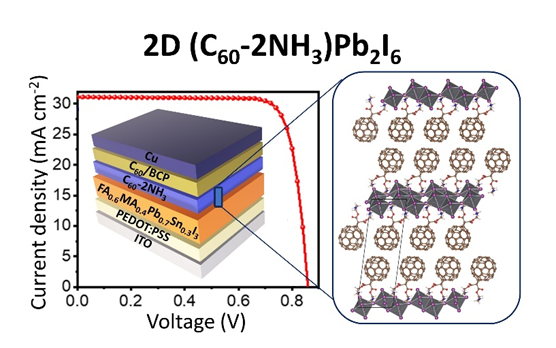Advantages:
- Higher Efficiency: C60-2NH3 interlayers increase PCE to 21.64% in mixed Sn-Pb perovskite solar cells.
- Improved Stability: (C60-2NH3)Pb2I6 reduces traps and defects, maintaining 90% of its initial efficiency after 2400h.
- Diverse Applications: Extends beyond photovoltaics to catalysis, transistors, and supercapacitors.
Summary:
This innovation addresses a strong market demand for sustainable and scalable energy solutions. The emergence of tin-lead (Sn-Pb) perovskite solar cells (PSCs) featuring amine-functionalized C60-2NH3 interlayers represents a breakthrough in photovoltaic technology. These advancements solve key challenges of lead-based perovskite systems by offering a compelling solution that combines high efficiency with long-term operational stability. The introduction of (C60-2NH3)Pb2I6, a crystalline fullerene-based 2D metal halide semiconductor, significantly enhances carrier transport efficiency and improves band energy alignment across layers, thereby reducing recombination and enhancing carrier mobility. With a remarkable 21.64% power conversion efficiency (PCE) and the ability to maintain 90% efficiency over extended storage periods, these solar cells represent a transformative approach to solar energy generation. The technology not only appeals to the renewable energy sector but also holds promise for broader applications in catalysis, transistors, and supercapacitors. This groundbreaking development answers the urgent need for eco-friendly and efficient energy technologies in today's dynamic market landscape.

The device architecture of the corresponding solar cell, along with its performance and interlayer crystal structure.
Desired Partnerships:
- License
- Sponsored Research
- Co-Development